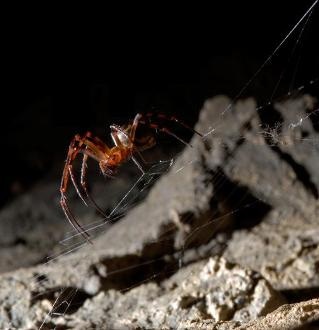Sep 15 2017
Researchers from the Graphene Flagship have established the fact that graphene-based materials are capable of enhancing the properties of spider's silk.
The silk - made naturally by the spiders, integrating graphene and carbon nanotubes (rolled up graphene sheets) introduced in their environment - had improved mechanical properties of up to ten times the toughness of the unmodified silks and three times the strength. The work has been published in 2D Materials and was a teamwork between the University of Trento, Italy and the Cambridge Graphene Centre at the University of Cambridge, UK, within the Polymer Composites Work Package of the Graphene Flagship.
 Natural spider silk has excellent mechanical properties. Researchers from the Graphene Flagship have found a way to boost the strength of spider's silk using graphene-based materials, paving the way for a novel class of high-performance bionic composites. CREDIT F. Tomasinelli
Natural spider silk has excellent mechanical properties. Researchers from the Graphene Flagship have found a way to boost the strength of spider's silk using graphene-based materials, paving the way for a novel class of high-performance bionic composites. CREDIT F. Tomasinelli
Biological materials that are artificially modified are considered to be a growing area of research. Natural materials can comprise of properties that cannot be attained with lab-produced materials, and acquiring inspiration from nature is an efficient research tool
The researchers improved the spider's silk by preparing solutions of graphene and carbon nanotubes (CNTs) which were sprayed inside the enclosure in which the spiders were kept. After permitting the spiders to ingest the graphene and CNT dispersions from their environment, silk was gathered from the spiders and then tested for CNT/graphene content and mechanical properties.
The silks exhibited improved mechanical properties when compared to reference silks gathered from the same spiders, with major increases in the toughness, elasticity and strength of the biocomposite silk threads. The sturdiest silk threads had a fracture strength of up to 5.4 GPa, more than three times as strong as that of the unmodified silks, and also a tenfold increase of toughness modulus up to 2.1 GPa.
This study paves way for new potentials for customizing the properties of biological materials in order to improve their properties for use in novel applications. For instance, these artificially modified silks are capable of finding use in biodegradable or high-performance textiles such as medical dressings or parachutes.
Humans have used silkworm silks widely for thousands of years, but recently research has focussed on spider silk, as it has promising mechanical properties. It is among the best spun polymer fibres in terms of tensile strength, ultimate strain, and especially toughness, even when compared to synthetic fibres such as Kevlar.
Nicola Pugno, of the University of Trento.
"We already know that there are biominerals present in the protein matrices and hard tissues of insects, which gives them high strength and hardness in their jaws, mandibles and teeth, for example. So our study looked at whether spider silk's properties could be 'enhanced' by artificially incorporating various different nanomaterials into the silk's biological protein structures," said Pugno.
This is the highest fibre toughness reported to date, and a strength comparable to that of the strongest carbon fibres or limpet teeth. These are still early days, but our results are a proof of concept that paves the way to exploiting the naturally efficient spider spinning process to produce reinforced bionic silk fibres, thus further improving one of the most promising strong materials.
Pugno.